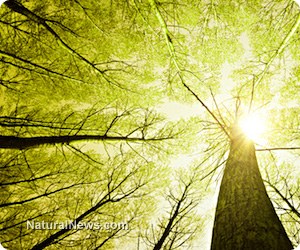naturalnews.com
Originally published December 29 2013
13-year-old inventor cracks the secret of trees to revolutionize solar energy
by L.J. Devon, Staff Writer(NaturalNews) A 13-year-old boy named Aidan Dwyer has an idea that can vastly improve solar energy technology. His idea is so revolutionary that it might make flat panel solar designs extinct.
Aidan discovered a spiral mathematical formula in trees based on the Fibonacci sequence. When he recognized this design in the placement of tree branches, he began applying the secret knowledge to solar panel designs. His discovery could maximize solar panel sunlight collection in new, efficient ways.
Discovering a pattern in tree trunks
On a winter hiking trip, Aidan noticed something unique about tree branches. After collecting photographs of various trees, he began to see a pattern among the random display of branches and leaves. Aidan realized that the overall branch pattern of trees resembled a spiral. Furthermore, he found a mathematical pattern behind the spiral of branches. To investigate further, he began building test models.Using the Fibonacci sequence to maximize sunlight collection
Upon investigating, Aidan discovered a pattern based on a number sequence invented by medieval mathematician Fibonacci. Fibonacci discovered a pattern when experimenting with a math puzzle. Through solving a problem about the rate at which rabbits reproduce over time, Fibonacci invented a sequence of numbers. Fibonacci invented a mathematical pattern, starting with zero and one. By adding two numbers to the series together, the new sum became the next number in the sequence. This sequence starts out with the numbers 1, 1, 2, 3, 5, 8, 13 and 21.This Fibonacci sequence and its ratios appear in nature, in many forms of life. According to Aidan, examples of this pattern can be found in the seeds of a sunflower, systems of the human body and even galaxies in space.
Aidan found that tree trunks contain similar patterns based on the Fibonacci sequence.
According to Aidan, "Tree branches follow a Fibonacci formula." He reports that, in an oak tree, branches are arranged in a two to five sequence. "Five branches spiral around the trunk two times to reach the same starting point on the trunk," he reports.
The patterns that he found also include the elm tree, which follows a one to two pattern, and the beech tree, which follows a one to three pattern. He found a three to eight pattern in the willow tree and a five to one pattern in the branch arrangement of almond trees.
Using the spiral pattern for maximum efficiency in solar panel technology
In trying to understand the meaning behind the pattern, Aidan hypothesized that the main goal of the leaves is to collect maximum sunlight for photosynthesis.To test this hypothesis, Aidan created mini tree models with sunlight-collecting solar panels. He arranged the mini panels in a spiral pattern based on the Fibonacci sequence design he observed in the trees.
Logging data on voltage and current, Aidan ran tests on the spiral design and on a flat panel design for several months. Click here to view his models.
He found out that the Fibonacci solar panel design was extremely more efficient than flat panel designs. The spiral patterns collect, on average, 20 percent more open current voltage and absorbs 2.5 more hours of sunlight per day.
Even more exciting were his results during the winter solstice when the sun is at its lowest point in the sky. During this time, the Fibonacci design collected 50 percent more sunlight than flat panel designs!
"My results suggest that the Fibonacci pattern can improve solar panel arrays in several ways. It collects more sunlight when the sun is at a low angle in the sky. This is useful during winter months and in extreme latitudes," Aidan explained.
He mentioned other benefits of the spiral design, saying that it will take up less room in urban areas, where space is limited. He also believes that the design would not collect as much rain and snow and be more weather-resistant than rooftop flat panel designs.
Sources for this article include:
http://www.minds.com
http://science.naturalnews.com
All content posted on this site is commentary or opinion and is protected under Free Speech. Truth Publishing LLC takes sole responsibility for all content. Truth Publishing sells no hard products and earns no money from the recommendation of products. NaturalNews.com is presented for educational and commentary purposes only and should not be construed as professional advice from any licensed practitioner. Truth Publishing assumes no responsibility for the use or misuse of this material. For the full terms of usage of this material, visit www.NaturalNews.com/terms.shtml



No comments:
Post a Comment